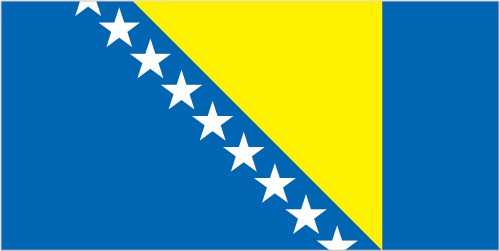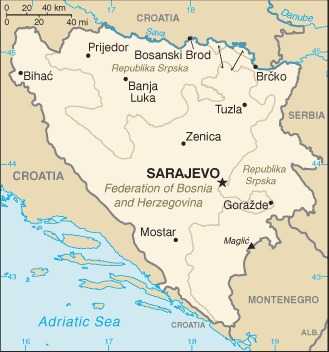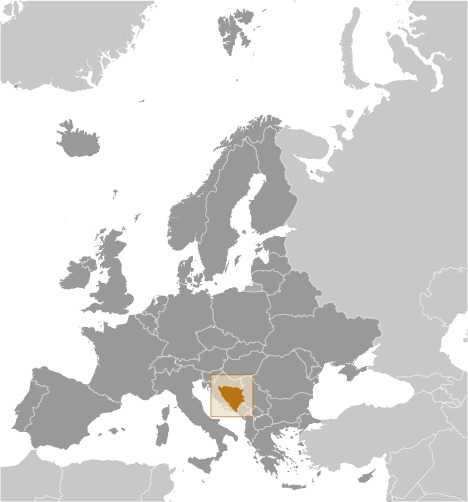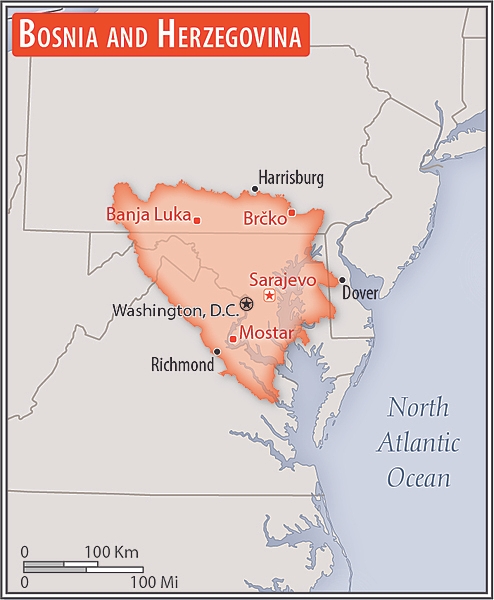Introduction
Background
After four centuries of Ottoman rule over Bosnia and Herzegovina, Austria-Hungary took control in 1878 and held the region until 1918, when it was incorporated into the newly created Kingdom of Serbs, Croats, and Slovenes. After World War II, Bosnia and Herzegovina joined the Socialist Federal Republic of Yugoslavia (SFRY).
Bosnia and Herzegovina declared sovereignty in October 1991 and independence from the SFRY on 3 March 1992 after a referendum boycotted by ethnic Serbs. Bosnian Serb militias, with the support of Serbia and Croatia, then tried to take control of territories they claimed as their own. From 1992 to 1995, ethnic cleansing campaigns killed thousands and displaced more than two million people. On 21 November 1995, in Dayton, Ohio, the warring parties initialed a peace agreement, and the final agreement was signed in Paris on 14 December 1995.
The Dayton Accords retained Bosnia and Herzegovina's international boundaries and created a multiethnic and democratic government composed of two entities roughly equal in size: the predominantly Bosniak-Bosnian Croat Federation of Bosnia and Herzegovina and the predominantly Bosnian Serb-led Republika Srpska (RS). The Dayton Accords also established the Office of the High Representative to oversee the agreement's implementation. In 1996, the NATO-led Stabilization Force (SFOR) took over responsibility for enforcing the peace. In 2004, European Union peacekeeping troops (EUFOR) replaced SFOR. As of 2022, EUFOR deploys around 1,600 troops in Bosnia in a peacekeeping capacity. Bosnia and Herzegovina became an official candidate for EU membership in 2022.
Visit the Definitions and Notes page to view a description of each topic.
Geography
Location
Southeastern Europe, bordering the Adriatic Sea and Croatia
Geographic coordinates
44 00 N, 18 00 E
Map references
Europe
Land boundaries
total: 1,543 km
border countries (3): Croatia 956 km; Montenegro 242 km; Serbia 345 km
Coastline
20 km
Climate
hot summers and cold winters; areas of high elevation have short, cool summers and long, severe winters; mild, rainy winters along coast
Terrain
mountains and valleys
Elevation
highest point: Maglic 2,386 m
lowest point: Adriatic Sea 0 m
mean elevation: 500 m
Natural resources
coal, iron ore, antimony, bauxite, copper, lead, zinc, chromite, cobalt, manganese, nickel, clay, gypsum, salt, sand, timber, hydropower
Land use
agricultural land: 42.2% (2018 est.)
arable land: 19.7% (2018 est.)
permanent crops: 2% (2018 est.)
permanent pasture: 20.5% (2018 est.)
forest: 42.8% (2018 est.)
other: 15% (2018 est.)
Irrigated land
30 sq km (2012)
Major watersheds (area sq km)
Atlantic Ocean drainage: (Black Sea) Danube (795,656 sq km)
Population distribution
the northern and central areas of the country are the most densely populated
Natural hazards
destructive earthquakes
Geography - note
within Bosnia and Herzegovina's recognized borders, the country is divided into a joint Bosniak/Croat Federation (about 51% of the territory) and the Bosnian Serb-led Republika Srpska or RS (about 49% of the territory); the region called Herzegovina is contiguous to Croatia and Montenegro, and traditionally has been settled by an ethnic Croat majority in the west and an ethnic Serb majority in the east
People and Society
Population
total: 3,798,671
male: 1,852,164
female: 1,946,507 (2024 est.)
comparison rankings: female 130; male 132; total 131
Nationality
noun: Bosnian(s), Herzegovinian(s)
adjective: Bosnian, Herzegovinian
Ethnic groups
Bosniak 50.1%, Serb 30.8%, Croat 15.4%, other 2.7%, not declared/no answer 1% (2013 est.)
note: Republika Srpska authorities dispute the methodology and refuse to recognize the results; Bosniak has replaced Muslim as an ethnic term in part to avoid confusion with the religious term Muslim - an adherent of Islam
Languages
Bosnian (official) 52.9%, Serbian (official) 30.8%, Croatian (official) 14.6%, other 1.6%, no answer 0.2% (2013 est.)
major-language sample(s):
Knjiga svjetskih činjenica, neophodan izvor osnovnih informacija. (Bosnian)
Knjiga svetskih činjenica, neophodan izvor osnovnih informacija. (Serbian)
Knjiga svjetskih činjenica, nužan izvor osnovnih informacija. (Croatian)
The World Factbook, the indispensable source for basic information.
Religions
Muslim 50.7%, Orthodox 30.7%, Roman Catholic 15.2%, atheist 0.8%, agnostic 0.3%, other 1.2%, undeclared/no answer 1.1% (2013 est.)
Age structure
0-14 years: 13.1% (male 257,444/female 240,209)
15-64 years: 68.3% (male 1,305,271/female 1,290,920)
65 years and over: 18.6% (2024 est.) (male 289,449/female 415,378)
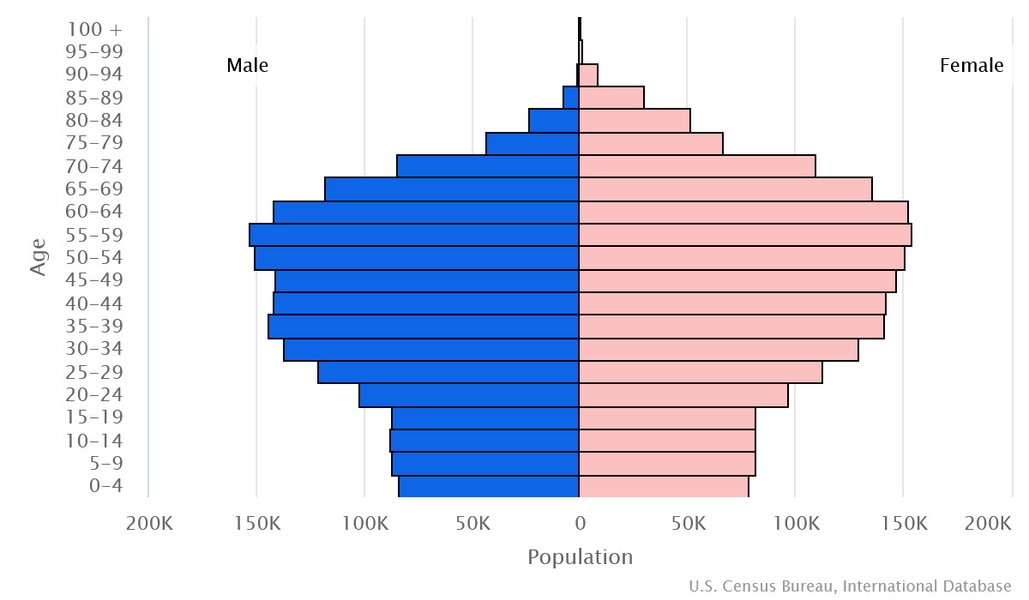
Dependency ratios
total dependency ratio: 48
youth dependency ratio: 22.3
elderly dependency ratio: 27.1
potential support ratio: 3.7 (2021 est.)
Median age
total: 44.8 years (2024 est.)
male: 43.1 years
female: 46.5 years
comparison ranking: total 28
Population distribution
the northern and central areas of the country are the most densely populated
Urbanization
urban population: 50.3% of total population (2023)
rate of urbanization: 0.61% annual rate of change (2020-25 est.)
Major urban areas - population
346,000 SARAJEVO (capital) (2023)
Sex ratio
at birth: 1.07 male(s)/female
0-14 years: 1.07 male(s)/female
15-64 years: 1.01 male(s)/female
65 years and over: 0.7 male(s)/female
total population: 0.95 male(s)/female (2024 est.)
Mother's mean age at first birth
27.7 years (2019 est.)
Infant mortality rate
total: 5 deaths/1,000 live births (2024 est.)
male: 5.1 deaths/1,000 live births
female: 4.9 deaths/1,000 live births
comparison ranking: total 176
Life expectancy at birth
total population: 78.5 years (2024 est.)
male: 75.5 years
female: 81.6 years
comparison ranking: total population 77
Gross reproduction rate
0.67 (2024 est.)
Contraceptive prevalence rate
45.8% (2011/12)
Drinking water source
improved: urban: 99.9% of population
rural: 100% of population
total: 99.9% of population
unimproved: urban: 0.1% of population
rural: 0% of population
total: 0.1% of population (2020 est.)
Current health expenditure
9.8% of GDP (2020)
Physician density
2.16 physicians/1,000 population (2015)
Hospital bed density
3.5 beds/1,000 population (2014)
Sanitation facility access
improved: urban: 99.5% of population
rural: NA
total: NA
unimproved: urban: 0.5% of population
rural: NA
total: (2020 est.) NA
Alcohol consumption per capita
total: 5.46 liters of pure alcohol (2019 est.)
beer: 4.19 liters of pure alcohol (2019 est.)
wine: 0.47 liters of pure alcohol (2019 est.)
spirits: 0.62 liters of pure alcohol (2019 est.)
other alcohols: 0.17 liters of pure alcohol (2019 est.)
comparison ranking: total 81
Tobacco use
total: 35% (2020 est.)
male: 42% (2020 est.)
female: 28% (2020 est.)
comparison ranking: total 15
Currently married women (ages 15-49)
63.8% (2023 est.)
Literacy
definition: age 15 and over can read and write
total population: 98.1%
male: 99.4%
female: 98.1% (2021)
School life expectancy (primary to tertiary education)
total: 14 years
male: 14 years
female: 15 years (2014)
Environment
Environment - current issues
air pollution; deforestation and illegal logging; inadequate wastewater treatment and flood management facilities; sites for disposing of urban waste are limited; land mines left over from the 1992-95 civil strife are a hazard in some areas
Environment - international agreements
party to: Air Pollution, Biodiversity, Climate Change, Climate Change-Kyoto Protocol, Climate Change-Paris Agreement, Comprehensive Nuclear Test Ban, Desertification, Endangered Species, Hazardous Wastes, Law of the Sea, Marine Life Conservation, Nuclear Test Ban, Ozone Layer Protection, Wetlands
signed, but not ratified: none of the selected agreements
Climate
hot summers and cold winters; areas of high elevation have short, cool summers and long, severe winters; mild, rainy winters along coast
Land use
agricultural land: 42.2% (2018 est.)
arable land: 19.7% (2018 est.)
permanent crops: 2% (2018 est.)
permanent pasture: 20.5% (2018 est.)
forest: 42.8% (2018 est.)
other: 15% (2018 est.)
Urbanization
urban population: 50.3% of total population (2023)
rate of urbanization: 0.61% annual rate of change (2020-25 est.)
Air pollutants
particulate matter emissions: 26.19 micrograms per cubic meter (2019 est.)
carbon dioxide emissions: 21.85 megatons (2016 est.)
methane emissions: 2.92 megatons (2020 est.)
Waste and recycling
municipal solid waste generated annually: 1,248,718 tons (2015 est.)
municipal solid waste recycled annually: 12 tons (2015 est.)
percent of municipal solid waste recycled: 0% (2015 est.)
Major watersheds (area sq km)
Atlantic Ocean drainage: (Black Sea) Danube (795,656 sq km)
Total water withdrawal
municipal: 310 million cubic meters (2020 est.)
industrial: 60 million cubic meters (2020 est.)
Total renewable water resources
37.5 billion cubic meters (2020 est.)
Government
Country name
conventional long form: none
conventional short form: Bosnia and Herzegovina
local long form: none
local short form: Bosna i Hercegovina
former: People's Republic of Bosnia and Herzegovina, Socialist Republic of Bosnia and Herzegovina
abbreviation: BiH
etymology: the larger northern territory is named for the Bosna River; the smaller southern section takes its name from the German word "herzog," meaning "duke," and the ending "-ovina," meaning "land," forming the combination denoting "dukedom"
Government type
parliamentary republic
Capital
name: Sarajevo
geographic coordinates: 43 52 N, 18 25 E
time difference: UTC+1 (6 hours ahead of Washington, DC, during Standard Time)
daylight saving time: +1hr, begins last Sunday in March; ends last Sunday in October
etymology: the name derives from the Turkish noun saray, meaning "palace" or "mansion," and the term ova, signifying "plain(s)," to give a meaning of "palace plains" or "the plains about the palace"
Administrative divisions
3 first-order administrative divisions - Brcko District (Brcko Distrikt) (ethnically mixed), Federation of Bosnia and Herzegovina (Federacija Bosne i Hercegovine) (predominantly Bosniak-Croat), Republika Srpska (predominantly Serb)
Independence
1 March 1992 (from Yugoslavia); note - referendum for independence completed on 1 March 1992; independence declared on 3 March 1992
National holiday
Independence Day, 1 March (1992) and Statehood Day, 25 November (1943) - both observed in the Federation of Bosnia and Herzegovina entity; Victory Day, 9 May (1945) and Dayton Agreement Day, 21 November (1995) - both observed in the Republika Srpska entity
note: there is no national-level holiday
Constitution
history: 14 December 1995 (constitution included as part of the Dayton Peace Accords); note - each of the political entities has its own constitution
amendments: decided by the Parliamentary Assembly, including a two-thirds majority vote of members present in the House of Representatives; the constitutional article on human rights and fundamental freedoms cannot be amended; amended several times, last in 2009
Legal system
civil law system; Constitutional Court review of legislative acts
International law organization participation
has not submitted an ICJ jurisdiction declaration; accepts ICCt jurisdiction
Citizenship
citizenship by birth: no
citizenship by descent only: at least one parent must be a citizen of Bosnia and Herzegovina
dual citizenship recognized: yes, provided there is a bilateral agreement with the other state
residency requirement for naturalization: 8 years
Suffrage
18 years of age, 16 if employed; universal
Executive branch
chief of state: Chairperson of the Presidency Denis BECIROVIC (chairperson since 16 March 2024; presidency member since 16 November 2022 - Bosniak seat); Zeljka CVIJANOVIC (presidency member since 16 November 2022 - Serb seat); Zeljko KOMSIC (presidency member since 20 November 2018 - Croat seat)
head of government: Chairperson of the Council of Ministers Borjana KRISTO (since 25 January 2023)
cabinet: Council of Ministers nominated by the council chairperson, approved by the state-level House of Representatives
elections/appointments: 3-member presidency (1 Bosniak and 1 Croat elected from the Federation of Bosnia and Herzegovina and 1 Serb elected from the Republika Srpska) directly elected by simple majority popular vote for a 4-year term (eligible for a second term but then ineligible for 4 years); the presidency chairpersonship rotates every 8 months with the new member of the presidency elected with the highest number of votes starting the new mandate as chair; election last held on 2 October 2022 (next to be held in October 2026); the chairperson of the Council of Ministers appointed by the presidency and confirmed by the state-level House of Representatives
election results:
2022: percent of vote - Denis BECIROVIC - (SDP BiH) 57.4% - Bosniak seat; Zeljko KOMSIC (DF) 55.8% - Croat seat; Zeljka CVIJANOVIC (SNSD) 51.7% - Serb seat
2018: percent of vote - Milorad DODIK (SNSD) 53.9% - Serb seat; Zeljko KOMSIC (DF) 52.6% - Croat seat; Sefik DZAFEROVIC (SDA) 36.6% - Bosniak seat
note: President of the Federation of Bosnia and Herzegovina Lidiia BRADARA (since 28 February 2023); Vice Presidents Refik LENDO (since 28 February 2023) and Igor STOJANOVIC (since 28 February 2023); President of the Republika Srpska Milorad DODIK (since 15 November 2022); Vice Presidents Camil DURAKOVIC (since 15 November 2022) and Davor PRANJIC (since 15 November 2022)
Legislative branch
description: bicameral Parliamentary Assembly or Skupstina consists of:
House of Peoples or Dom Naroda (15 seats - 5 Bosniak, 5 Croat, 5 Serb; members designated by the Federation of Bosnia and Herzegovina's House of Peoples and the Republika Srpska's National Assembly serve 4-year terms)
House of Representatives or Predstavnicki Dom (42 seats to include 28 seats allocated to the Federation of Bosnia and Herzegovina and 14 to the Republika Srpska; members directly elected by proportional representation vote to serve 4-year terms); note - the Federation of Bosnia and Herzegovina has a bicameral legislature that consists of the House of Peoples (80 seats - 23 Bosniak, 23 Croat, 23 Serb, 11 other) and the House of Representatives (98 seats; members directly elected by proportional representation vote to serve 4-year terms); Republika Srpska's unicameral legislature is the National Assembly or Narodna skupština Republike Srpske (83 directly elected delegates serve 4-year terms)
elections: House of Peoples - last held on 2 October 2022 (next to be held in 2026)
House of Representatives - last held on 2 October 2022 (next to be held in 2026)
election results: House of Peoples - percent of vote by party/coalition - NA; seats by party/coalition - NA; composition - men 13, women 2, percentage women 13.3%
House of Representatives - percent of vote by party/coalition - SDA 17.2%, SNSD 16.3%, HDZ BiH 8.8%, SDP 8.2%, SDS 7.1%, DF-GS 6.4%, NiP 5%, PDP 4.6%, NS/HC 3.1%, NES 3%, For Justice and Order 2.1%, DEMOS 1.9%, US 1.6%, BHI KF 1.3%, other 13.4%; seats by party/coalition - SDA 9, SNSD 6, SDP 5, HDZ BiH 4, DF-GS 3, NiP 3, SDS 2, PDP 2, NS/HC 2, NES 2, For Justice and Order 1, DEMOS 1, US 1, BHI KF 1; composition - men 34, women 8, percentage women 19.1%; total Parliamentary Assembly percentage women 17.5%
Judicial branch
highest court(s): Bosnia and Herzegovina (BiH) Constitutional Court (consists of 9 members); Court of BiH (consists of 44 national judges and 7 international judges organized into 3 divisions - Administrative, Appellate, and Criminal, which includes a War Crimes Chamber)
judge selection and term of office: BiH Constitutional Court judges - 4 selected by the Federation of Bosnia and Herzegovina House of Representatives, 2 selected by the Republika Srpska's National Assembly, and 3 non-Bosnian judges selected by the president of the European Court of Human Rights; Court of BiH president and national judges appointed by the High Judicial and Prosecutorial Council; Court of BiH president appointed for renewable 6-year term; other national judges appointed to serve until age 70; international judges recommended by the president of the Court of BiH and appointed by the High Representative for Bosnia and Herzegovina; international judges appointed to serve until age 70
subordinate courts: the Federation has 10 cantonal courts plus a number of municipal courts; the Republika Srpska has a supreme court, 5 district courts, and a number of municipal courts
Political parties and leaders
Alliance of Independent Social Democrats or SNSD [Milorad DODIK]
Bosnian-Herzegovinian Initiative or BHI KF [Fuad KASUMOVIC]
Civic Alliance or GS [Reuf BAJROVIC]
Croatian Democratic Union of Bosnia and Herzegovina or HDZ-BiH [Dragan COVIC]
Democratic Front or DF [Zeljko KOMSIC]
Democratic Union or DEMOS [Nedeljko CUBRILOVIC]
For Justice and Order [Nebojsa VUKANOVIC]
Our Party or NS/HC [Edin FORTO]
Party for Democratic Action or SDA [Bakir IZETBEGOVIC]
Party of Democratic Progress or PDP [Branislav BORENOVIC]
People and Justice Party or NiP [Elmedin KONAKOVIC]
People's European Union of Bosnia and Herzegovina or NES [Nermin OGRESEVIC]
Serb Democratic Party or SDS [Milan MILICEVIC]
Social Democratic Party or SDP [Nermin NIKSIC]
United Srpska or US [Nenad STEVANDIC]
International organization participation
BIS, CD, CE, CEI, EAPC, EBRD, FAO, G-77, IAEA, IBRD, ICAO, ICC (NGOs), ICCt, ICRM, IDA, IFAD, IFC, IFRCS, ILO, IMF, IMO, IMSO, Interpol, IOC, IOM, IPU, ISO, ITSO, ITU, ITUC (NGOs), MIGA, MONUSCO, NAM (observer), OAS (observer), OIC (observer), OIF (observer), OPCW, OSCE, PFP, SELEC, UN, UNCTAD, UNESCO, UNIDO, UNWTO, UPU, WCO, WHO, WIPO, WMO, WTO (observer)
note: Bosnia-Herzegovina is an EU candidate country whose satisfactory completion of accession criteria is required before being granted full EU membership
Diplomatic representation in the US
chief of mission: Ambassador Sven ALKALAJ (since 30 June 2023)
chancery: 2109 E Street NW, Washington, DC 20037
telephone: [1] (202) 337-1500
FAX: [1] (202) 337-1502
email address and website:
info@bhembassy.org
http://www.bhembassy.org/index.html
consulate(s) general: Chicago
Diplomatic representation from the US
chief of mission: Ambassador Michael J. MURPHY (since 23 February 2022)
embassy: 1 Robert C. Frasure Street, 71000 Sarajevo
mailing address: 7130 Sarajevo Place, Washington DC 20521-7130
telephone: [387] (33) 704-000
FAX: [387] (33) 659-722
email address and website:
sarajevoACS@state.gov
https://ba.usembassy.gov/
branch office(s): Banja Luka, Mostar
Flag description
a wide blue vertical band on the fly side with a yellow isosceles triangle abutting the band and the top of the flag; the remainder of the flag is blue with seven full five-pointed white stars and two half stars top and bottom along the hypotenuse of the triangle; the triangle approximates the shape of the country and its three points stand for the constituent peoples - Bosniaks, Croats, and Serbs; the stars represent Europe and are meant to be continuous (thus the half stars at top and bottom); the colors (white, blue, and yellow) are often associated with neutrality and peace, and traditionally are linked with Bosnia
note: one of several flags where a prominent component of the design reflects the shape of the country; other such flags are those of Brazil, Eritrea, and Vanuatu
National symbol(s)
golden lily; national colors: blue, yellow, white
National anthem
name: "Drzavna himna Bosne i Hercegovine" (The National Anthem of Bosnia and Herzegovina)
lyrics/music: none officially/Dusan SESTIC
note: music adopted 1999; lyrics proposed in 2008 and others in 2016 were not approved
National heritage
total World Heritage Sites: 4 (3 cultural, 1 natural)
selected World Heritage Site locales: Old Bridge Area of Mostar (c); Mehmed Paša Sokolović Bridge (c); Stećci Medieval Tombstones Graveyards (c); Primeval Beech Forests - Janj Forest (n)
Economy
Economic overview
import-dominated economy; remains consumption-heavy; lack of private sector investments and diversification; jointly addressing structural economic challenges; Chinese energy infrastructure investments; high unemployment; tourism industry impacted by COVID-19
Real GDP (purchasing power parity)
$63.769 billion (2023 est.)
$62.717 billion (2022 est.)
$60.174 billion (2021 est.)
note: data in 2021 dollars
comparison ranking: 113
Real GDP growth rate
1.68% (2023 est.)
4.23% (2022 est.)
7.39% (2021 est.)
note: annual GDP % growth based on constant local currency
comparison ranking: 150
Real GDP per capita
$19,900 (2023 est.)
$19,400 (2022 est.)
$18,400 (2021 est.)
note: data in 2021 dollars
comparison ranking: 103
GDP (official exchange rate)
$27.055 billion (2023 est.)
note: data in current dollars at official exchange rate
Inflation rate (consumer prices)
1.98% (2021 est.)
-1.05% (2020 est.)
0.56% (2019 est.)
comparison ranking: 34
Credit ratings
Moody's rating: B3 (2012)
Standard & Poors rating: B (2011)
note: The year refers to the year in which the current credit rating was first obtained.
GDP - composition, by sector of origin
agriculture: 6.8% (2017 est.)
industry: 28.9% (2017 est.)
services: 64.3% (2017 est.)
comparison rankings: services 98; industry 85; agriculture 112
GDP - composition, by end use
household consumption: 77.4% (2017 est.)
government consumption: 20% (2017 est.)
investment in fixed capital: 16.6% (2017 est.)
investment in inventories: 2.3% (2017 est.)
exports of goods and services: 38.7% (2017 est.)
imports of goods and services: -55.1% (2017 est.)
Agricultural products
maize, milk, vegetables, potatoes, plums, wheat, apples, barley, chicken, pears (2022)
note: top ten agricultural products based on tonnage
Industries
steel, coal, iron ore, lead, zinc, manganese, bauxite, aluminum, motor vehicle assembly, textiles, tobacco products, wooden furniture, ammunition, domestic appliances, oil refining
Industrial production growth rate
-2.8% (2023 est.)
note: annual % change in industrial value added based on constant local currency
comparison ranking: 190
Labor force
1.369 million (2023 est.)
note: number of people ages 15 or older who are employed or seeking work
comparison ranking: 140
Unemployment rate
10.42% (2023 est.)
12.66% (2022 est.)
14.9% (2021 est.)
note: % of labor force seeking employment
comparison ranking: 169
Youth unemployment rate (ages 15-24)
total: 32.9% (2021 est.)
male: 28.2%
female: 39.9%
comparison ranking: total 30
Population below poverty line
16.9% (2015 est.)
note: % of population with income below national poverty line
Average household expenditures
on food: 30% of household expenditures (2021 est.)
on alcohol and tobacco: 8.2% of household expenditures (2021 est.)
Household income or consumption by percentage share
lowest 10%: 2.9%
highest 10%: 25.8% (2011 est.)
Remittances
10.53% of GDP (2023 est.)
10.52% of GDP (2022 est.)
10.47% of GDP (2021 est.)
note: personal transfers and compensation between resident and non-resident individuals/households/entities
Budget
revenues: $8.434 billion (2019 est.)
expenditures: $8.154 billion (2019 est.)
Public debt
41.74% of GDP (2022 est.)
46.97% of GDP (2021 est.)
45.42% of GDP (2020 est.)
note: central government debt as a % of GDP
comparison ranking: 127
Taxes and other revenues
19.09% (of GDP) (2022 est.)
note: central government tax revenue as a % of GDP
comparison ranking: 94
Current account balance
-$760.467 million (2023 est.)
-$1.065 billion (2022 est.)
-$418.984 million (2021 est.)
note: balance of payments - net trade and primary/secondary income in current dollars
comparison ranking: 130
Exports
$11.942 billion (2023 est.)
$11.794 billion (2022 est.)
$10.058 billion (2021 est.)
note: balance of payments - exports of goods and services in current dollars
comparison ranking: 108
Exports - partners
Croatia 14%, Germany 14%, Serbia 13%, Italy 10%, Austria 9% (2022)
note: top five export partners based on percentage share of exports
Exports - commodities
aluminum, electricity, footwear, garments, plastic products (2022)
note: top five export commodities based on value in dollars
Imports
$15.398 billion (2023 est.)
$15.162 billion (2022 est.)
$12.738 billion (2021 est.)
note: balance of payments - imports of goods and services in current dollars
comparison ranking: 105
Imports - partners
Croatia 16%, Serbia 13%, Germany 8%, Italy 8%, China 7% (2022)
note: top five import partners based on percentage share of imports
Imports - commodities
refined petroleum, aluminum, garments, coal, cars (2022)
note: top five import commodities based on value in dollars
Reserves of foreign exchange and gold
$9.205 billion (2023 est.)
$8.762 billion (2022 est.)
$9.475 billion (2021 est.)
note: holdings of gold (year-end prices)/foreign exchange/special drawing rights in current dollars
comparison ranking: 87
Debt - external
$10.87 billion (31 December 2017 est.)
$10.64 billion (31 December 2016 est.)
comparison ranking: 112
Exchange rates
konvertibilna markas (BAM) per US dollar -
Exchange rates:
1.809 (2023 est.)
1.859 (2022 est.)
1.654 (2021 est.)
1.717 (2020 est.)
1.747 (2019 est.)
Energy
Electricity access
electrification - total population: 100% (2022 est.)
Electricity
installed generating capacity: 4.591 million kW (2022 est.)
consumption: 12.648 billion kWh (2022 est.)
exports: 6.856 billion kWh (2022 est.)
imports: 3.828 billion kWh (2022 est.)
transmission/distribution losses: 1.353 billion kWh (2022 est.)
comparison rankings: transmission/distribution losses 113; imports 50; exports 33; consumption 93; installed generating capacity 91
Electricity generation sources
fossil fuels: 69.3% of total installed capacity (2022 est.)
solar: 0.7% of total installed capacity (2022 est.)
wind: 2.3% of total installed capacity (2022 est.)
hydroelectricity: 27.7% of total installed capacity (2022 est.)
biomass and waste: 0.1% of total installed capacity (2022 est.)
Coal
production: 14.114 million metric tons (2022 est.)
consumption: 14.766 million metric tons (2022 est.)
exports: 739,000 metric tons (2022 est.)
imports: 1.425 million metric tons (2022 est.)
proven reserves: 2.264 billion metric tons (2022 est.)
Petroleum
refined petroleum consumption: 36,000 bbl/day (2022 est.)
Natural gas
consumption: 225.824 million cubic meters (2022 est.)
imports: 225.824 million cubic meters (2022 est.)
Carbon dioxide emissions
25.762 million metric tonnes of CO2 (2022 est.)
from coal and metallurgical coke: 20.191 million metric tonnes of CO2 (2022 est.)
from petroleum and other liquids: 5.141 million metric tonnes of CO2 (2022 est.)
from consumed natural gas: 430,000 metric tonnes of CO2 (2022 est.)
comparison ranking: total emissions 78
Communications
Telephones - fixed lines
total subscriptions: 651,000 (2022 est.)
subscriptions per 100 inhabitants: 20 (2022 est.)
comparison ranking: total subscriptions 84
Telephones - mobile cellular
total subscriptions: 3.812 million (2022 est.)
subscriptions per 100 inhabitants: 118 (2022 est.)
comparison ranking: total subscriptions 137
Telecommunication systems
general assessment: the telecom market has been liberalized and a regulatory framework created based on the EU’s regulatory framework for communications; although Bosnia-Herzegovina remains an EU candidate country, in July 2017 it applied amended mobile roaming charges to fit in with changes introduced across the Union; further roaming agreements were made in 2019 with other western Balkan countries; the fixed-line broadband network is comparatively underdeveloped, with the result that investments made in mobile upgrades to facilitate broadband connectivity in the country to a greater extent than is common elsewhere in Europe; internet services are available; DSL and cable are the main platforms for fixed-line connectivity, while fiber broadband as yet has only a small market presence; the three MNOs, each affiliated with one of the incumbent fixed-line operators, provide national coverage with 3G, though LTE coverage is only about 89%; their upgraded networks are helping to support broadband in rural areas where fixed-line infrastructure is insufficient; mobile data and mobile broadband offers will provide future revenue growth given the limited potential of mobile voice services; the MNOs tested LTE services under trial licenses from 2013, commercial launches were delayed until the award of spectrum in early 2019; the regulator stipulated that licenses must provide national coverage within five years; trials of 5G technology have been undertaken, though there are no plans to launch services commercially in the short term, given that the MNOs can continue to exploit the capacity of their existing LTE networks (2021)
domestic: fixed-line teledensity roughly 21 per 100 persons and mobile-cellular subscribership stands at 114 telephones per 100 persons (2021)
international: country code - 387; no satellite earth stations
Broadcast media
3 public TV broadcasters: Radio and TV of Bosnia and Herzegovina, Federation TV (operating 2 networks), and Republika Srpska Radio-TV; a local commercial network of 5 TV stations; 3 private, near-national TV stations and dozens of small independent TV broadcasting stations; 3 large public radio broadcasters and many private radio stations (2019)
Internet users
total: 2.508 million (2021 est.)
percent of population: 76% (2021 est.)
comparison ranking: total 128
Broadband - fixed subscriptions
total: 770,424 (2020 est.)
subscriptions per 100 inhabitants: 24 (2020 est.)
comparison ranking: total 78
Transportation
National air transport system
number of registered air carriers: 1 (2020)
inventory of registered aircraft operated by air carriers: 1
annual passenger traffic on registered air carriers: 7,070 (2015)
annual freight traffic on registered air carriers: 87 (2015) mt-km
Heliports
3 (2024)
Pipelines
147 km gas, 9 km oil (2013)
Railways
total: 965 km (2014)
standard gauge: 965 km (2014) 1.435-m gauge (565 km electrified)
comparison ranking: total 91
Waterways
990 km (2022) (Sava River on northern border; open to shipping but use limited)
comparison ranking: 70
Ports
total ports: 1 (2024)
large: 0
medium: 0
small: 1
very small: 0
ports with oil terminals: 0
key ports: Neum
Military and Security
Military and security forces
Armed Forces of Bosnia and Herzegovina (AFBiH or Oruzanih Snaga Bosne i Hercegovine, OSBiH): Army, Air, Air Defense forces organized into an Operations Command and a Support Command
Ministry of Security: Border Police (2024)
Military expenditures
0.8% of GDP (2023 est.)
0.8% of GDP (2022)
0.9% of GDP (2021)
0.9% of GDP (2020)
0.8% of GDP (2019)
comparison ranking: 136
Military and security service personnel strengths
approximately 10,000 active-duty personnel (2023)
Military equipment inventories and acquisitions
the military's inventory is largely Soviet-era material with a smaller mix of mostly secondhand from other countries, particularly the US (2023)
Military service age and obligation
18 years of age for voluntary military service; conscription abolished in 2005 (2023)
note: as of 2022, women made up about 7% of the military's full-time personnel
Military - note
the Armed Forces of Bosnia and Herzegovina (AFBiH) are comprised of the former Bosnian-Croat Army of the Federation of Bosnia and Herzegovina (Vojska Federacije Bosne i Hercegovin, VF) and the Bosnian-Serb Republic of Serbia Army (Vojska Republike Srpske, VRS); the two forces were unified under the 2006 Law on Defense, and the combined force includes each ethnic group; the 2006 law also established the country’s Ministry of Defense
the AFBiH is responsible for territorial defense, providing assistance to civil authorities during disasters or other emergencies, and participating in collective security and peace support operations; each of the AFBiH's three combat brigades are headquartered inside of their respective ethnicity territory, while its main headquarters is in Sarajevo; Bosnia and Herzegovina aspires to join NATO; it joined NATO’s Partnership for Peace (PfP) program in 2007 and was invited to join NATO’s Membership Action Plan in 2010; the AFBiH is undergoing a defense modernization and reform program for preparing to join and integrate with NATO; it has contributed small numbers of troops to EU, NATO, and UN missions
NATO maintains a military headquarters in Sarajevo with the mission of assisting Bosnia and Herzegovina with the PfP program and promoting closer integration with NATO, as well as providing logistics and other support to the EU Force Bosnia and Herzegovina (EUFOR), which has operated in the country to oversee implementation of the Dayton/Paris Agreement since taking over from NATO's Stabilization Force (SFOR) in 2004; EUFOR has about 1,100 troops from 22 countries (2023)
Terrorism
Terrorist group(s)
Terrorist group(s): Islamic Revolutionary Guard Corps/Qods Force
note: details about the history, aims, leadership, organization, areas of operation, tactics, targets, weapons, size, and sources of support of the group(s) appear(s) in the Terrorism reference guide
Transnational Issues
Refugees and internally displaced persons
IDPs: 91,000 (Bosnian Croats, Serbs, and Bosniaks displaced by inter-ethnic violence, human rights violations, and armed conflict during the 1992-95 war) (2022)
stateless persons: 48 (2022)
note: 153,304 estimated refugee and migrant arrivals (January 2015-March 2024)
Illicit drugs
drug trafficking groups are major players in the procurement and transportation of of large quantities of cocaine destined for European markets

